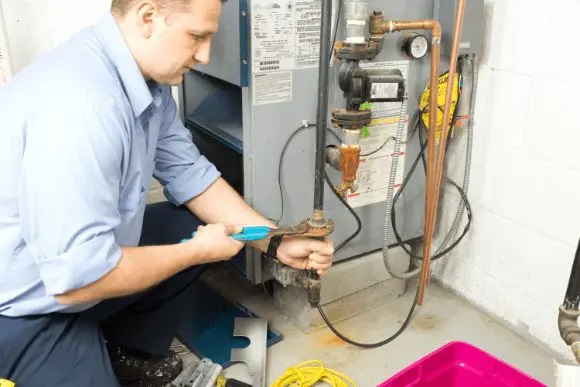A properly functioning furnace is critical during those freezing winter months. However, you may encounter situations where your furnace pilot light just isn’t cooperating. But worry not! This guide is designed to provide you with a comprehensive overview of the possible problems that could cause this issue and their respective solutions.
Let’s dissect the issue and explore the steps you can take to get your furnace back to its full operational capacity.
If you’re noticing issues with your furnace’s pilot light or have any other maintenance or service needs, contact IMS Heating and Air Inc., your local furnace experts in Loveland, CO, for reliable furnace repair assistance.
Check your gas levels
Most people don’t realize this, but your furnace requires a small amount of natural gas to power the pilot light. Without enough gas, the pilot won’t light, leading to continuous failure until professional assistance can be called upon to assess and adjust your gas supply and adjust the flow as necessary.
Relight your pilot carefully. Failing to do so correctly could result in its tip becoming clogged with soot, no longer able to create the small flame that keeps your system operating.
To relight it properly, press and hold the reset button while using a long lighter (such as those typically found for grills) to light your pilot flame – holding both together until the flame lights steadily before releasing both and switching your gas valve back onto “ON.”
Tittering with your furnace can be hazardous. If the pilot light remains out after you relight it and needs addressing with thermocouples, then consulting a service professional is advised – they will identify any possible issues and recommend the appropriate replacement parts for your furnace.
Clean the tip of the pilot
Your pilot light’s ignitor must be in excellent condition in order to keep its flame lit, or else it could become fouled with soot and cease producing enough electricity to fuel its burning. A toothbrush can easily help clean off its tip.
Before attempting to relight your pilot, it is imperative that you first ensure the gas in your furnace has been completely shut off. If not addressed, this might lead to severe physical injuries and damage to property.
To do this, consult the manual for your furnace and follow its directions for turning off power; additionally, double-check that the paddle-on switch that controls the furnace has not been flipped by accident.
Once the gas is turned off, open up your access panel and remove the front of your furnace to expose its pilot flame. For automatic pilot lights, relighting may simply involve pushing in on the gas control knob to rotate to the pilot position.
With manual pilot lights, you must hold in a match flame while pressing a red button that pushes gas towards it manually – though you should take extra care not to touch or come into contact with any part of the system during this process to avoid any burning.
Clean the intake valve
The pilot light is an important safety feature of your furnace that helps ensure its proper operation. When working properly, its flame should be bright blue in color. Any time that color fades to yellow or orange, it could indicate that a dirty pilot light orifice needs cleaning out.
Dirt can restrict oxygen from reaching the pilot light, making it weak or flicker. Cleaning your intake valve is a quick and simple way to restore this supply and should be performed during an annual furnace tune-up so there won’t be an interruption when using your system during the heating season.
Before cleaning your intake valve, be sure that both power and gas have been turned off at their respective main valves. Also, identify and switch your pilot light to “PILOT.” After making these adjustments, wait several minutes to ensure all gas has dissipated from your system.
Once this has been accomplished, flip back the breaker and follow your furnace manual’s instructions to relight your pilot light. If it continues to go out without lighting again, this could indicate a problem with the thermocouple; should this occur, you should seek professional assistance, as they can inspect your system and recommend an ignitor that best fits.
Check the thermocouple
If the pilot light is flickering out unexpectedly, it may be due to issues with your thermocouple. A thermocouple is a device that detects whether or not the pilot light remains lit and sends this information on to your gas valve; when dirty it won’t be able to pick up on this information and could even lead to system shutdown.
Thermocouples are composed of dissimilar metals connected together, and when exposed to heat, their tip generates voltage. As temperatures increase, so does this voltage output; when covered in soot, however, it won’t generate as much power and won’t open your gas valve.
Your thermocouple can be tested by turning off your gas, waiting five minutes so any ambient gas can dissipate, and attempting to relight the pilot again. Be wary when testing the thermocouple as it can easily bend under stress – this could compromise its ability to work correctly. Using fine-grain sandpaper will help remove any buildup on its sensor tip that might prevent its proper function.
What to do if Your Furnace Pilot Light Isn’t Working – conclusion
Troubleshooting a furnace’s pilot light involves a step-by-step approach, examining elements such as the gas levels, ignitor, intake valve, and thermocouple. Regular maintenance and cleaning are crucial to ensure the proper functioning of these components. However, if the pilot light continues to go out, seeking professional assistance is the safest and most effective course of action.
